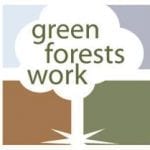
CONTACT
Dr. Christopher Barton
President, Green Forests Work
ude.yku@notrab
(859) 619-1532
WHAT: Earth Day Tree Planting on a Reclaimed Surface Mine
WHEN: Saturday, April 22, 2017 at 10:30am
WHERE: Breathitt County, Kentucky: Paul Van Booven Wildlife Management Area
FOR IMMEDIATE RELEASE
April 17, 2017
Artistic Community Joins Green Forests Work on Earth Day to Plant 2 Millionth Tree on Reclaimed Coal Mine
On Saturday, April 22, 2017, Green Forests Work (GFW), in cooperation with the Appalachian Regional Reforestation Initiative, the Arbor Day Foundation, The American Chestnut Foundation, the University of Kentucky Appalachian Center and Kentucky Writers and Artists for Reforestation will host a volunteer tree planting event in Breathitt County, Kentucky in support of Earth Day and the Plant for the Planet: Billion Tree Campaign. This event will involve local writers, artists and other volunteers who will plant thousands of indigenous hardwood trees and wildlife shrubs to restore forest habitat in an area that was previously mined for coal.
Inspired by 2004 Nobel Peace Prize Laureate Wangari Maathai who believed that, “When we plant trees, we plant the seeds of peace and seeds of hope”, Green Forests Work continues to fulfill its commitment to plant for the planet’s present and future generations.
Since 2009, GFW has supported the reforestation of thousands of acres of surface mined land in eight states – Alabama, Kentucky, Maryland, Ohio, Pennsylvania, Tennessee, Virginia and West Virginia.
“This planting event will celebrate the two millionth tree planted by Green Forests Work”, says Dr. Christopher Barton of the University of Kentucky and President of Green Forests Work.
The reforestation site, owned by the University of Kentucky, was surface mined for coal and reclaimed more than a decade ago using traditional post-Surface Mining Control and Reclamation Act (post-SMCRA) techniques. Reclamation techniques at that time often resulted in heavily compacted soils which were seeded with aggressive, non-native grasses and legumes which hindered the development of native
forests. The location where the two millionth tree will be planted was quickly becoming dominated by exotic invasive species. GFW prepared the land using the Forestry Reclamation Approach (FRA) – a method which breaks up the compacted soil so that trees can grow successfully. To prepare for this milestone in GFW’s effort, exotic shrubs were removed from the site and the compacted ground was loosened by cross-ripping (plowing) with a large bulldozer. This method provides a good rooting environment for the plants, and allows rainfall to infiltrate the ground instead of running off, therefore reducing erosion and improving water quality in local streams.
“United Nations Environment is encouraged that their inaugural Plant for the Planet initiative gave birth to the successful Green Forests Work. I would like to congratulate all those who have committed their time, energy and knowledge to the rehabilitation of coal mined areas,” says Fatou Ndoye, Acting Director of UN Environment’s North America Office.
“Forests are critical to global biodiversity as they help conserve soil and water, provide genetic resources and natural medicines, prevent desertification, protect coastal areas, and control avalanches. Safeguarding forests also makes good economic sense since the goods and services they provide are worth billions of dollars to the international economy,” added Ndoye.
“GFW’s reforestation projects not only benefit the environment through the creation of wildlife habitat, they also provide clean air and water and help mitigate climate change. Many of the trees and shrubs we are planting will benefit pollinators and other imperiled species, such as neo-tropical songbirds and bats. These projects will also provide economic opportunities through site preparation, seedling production, forest management, and the future harvesting of timber and non-timber forest products,” explains Barton.
Rehabilitation of these mines provides new opportunities for lands that are often considered marginal and contributes significantly to the development of a sustainable and economically viable future.
The inspiration provided by Nobel Prize winner Wangari Maathai is encapsulated in her belief that “… the act of planting a tree reconnects the human spirit to the beauty and importance of the natural world – the basis for all life on Earth”. This belief is also at the heart of the many volunteers who will come together on 22 April 2017 to plant trees in an important part of the United States: Appalachia.
Note to Editors
The Appalachian Regional Reforestation Initiative (ARRI) was created by the U.S. Office of Surface Mining and Reclamation Enforcement and the Appalachian coal state regulatory authorities. ARRI, which pledged to plant 38 million trees, grew into Green Forests Work whereby 125 million trees will be planted.
Green Forests Work (GFW) is a non-profit conservation organization created by ARRI to restore healthy, productive forests on formerly mined lands across Appalachia.
For more information about Green Forests Work, please contact Michael French at: (812) 447-3285 or email: gro.krowstserofneerg@hcnerf.leahcim. Or visit www.greenforestswork.org.
